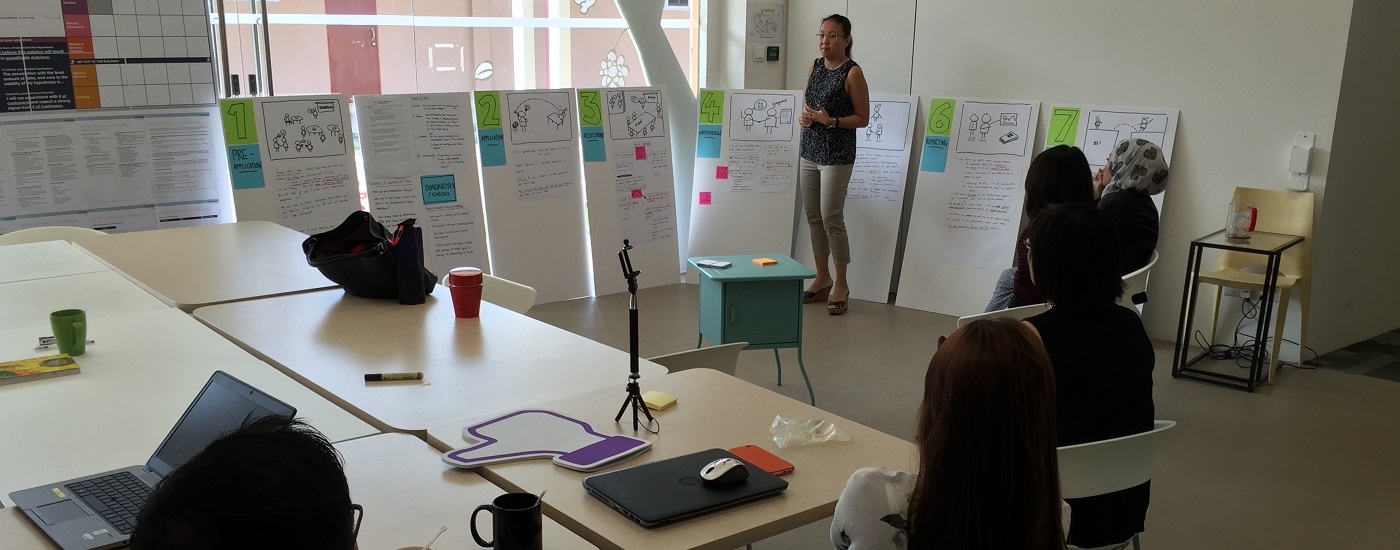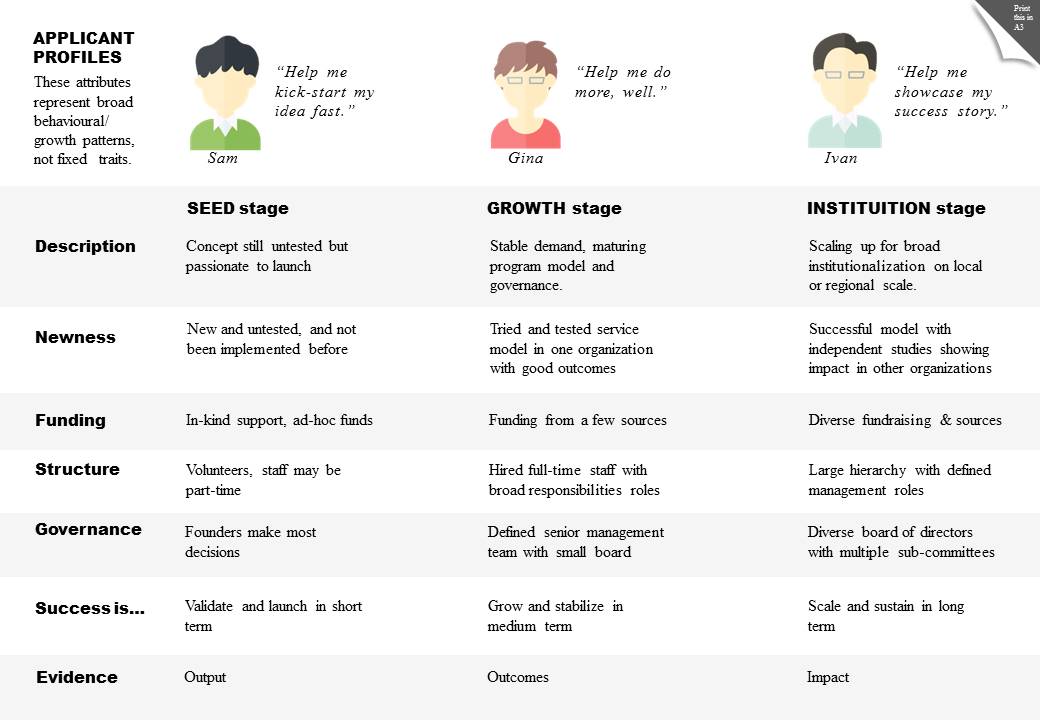Designing a new end-to-end grant experience with SG Enable, from ground up, from outside in. This is part 3 of a 3-part series. Read parts 1 and 2.
Applicant profiles: looking beyond the average applicant
From the synthesis of our findings, we had a hunch that there were 3 hypothetical groups of grant applicants. These fictional profiles are useful by showing us how one size does not fit all when it comes to managing the grant. Through these 3 profiles, we can envision different ways of support and resourcing for groups of organizations in a more nuanced and targeted way that meet their needs based on its growth phase in the life cycle of their organization or service.
Concept still untested but passionate to launch. “Help me kick-start my idea fast.”
Stable demand, maturing program model and governance. “Help me do more, well.”
Scaling up for broad institutionalization on local or regional scale. “Help me showcase my success story.”
The ideal grant experience
Based on the insights from the previous section, we brainstormed ideas around the ideal experience that a grant applicant would go through together with SG Enable. We re-imagined how our ideas would flow in each stage in their journey with us. This is called a user journey. Hence the storyboards serve to illustrate the spectrum of interactions and activities offered by the grant, how different stakeholders would interact with one another, and how the grant might benefit VWOs, social enterprises, research institutes, funders and other stakeholders. These scenarios of interaction show how the different stages of the grant are structured to serve the needs and alleviate the pain-points of the different stakeholders who are part of the grant process. We can break down their journey into 7 stages: 1) pre-application, 2) application, 3) assessment, 4) notification, 5) implementation, 6) reporting, 7) closure.
1 / Pre-application
Setting the tone right by a human first touch. Seeding collaborations at the onset.
Sam receive an EDM in his email that tells him about an exciting new grant called the TB-ELI Grant. He attends a fun briefing hosted by Ai Ling from SG Enable, where they shared an interesting presentation about the new grant and assessment criteria. What’s even interesting is how they shared the larger intent and mission the grant wish to achieve for the disability sector. It was an inspiring vision. At the briefing, Sam meets interesting people from diverse fields – social sector, technologists, researchers, industry experts, and also Ai Ling, the friendly go-to people for any queries about the grant. He exchanged name cards, made lots of new connections on LinkedIn and Facebook. What made him most excited are the ideas exchanged and possible collaborations with a VWO and research institute. He decides to fill out the application form for an idea his social enterprise had been testing out. The form was easy to understand, written in simple language, visually appealing. There’s even examples on how to think through the logic model, including an eligibility criteria checklist and a diagnostic checklist to help self-evaluation. Information on website provides more details and the FAQs answered most of his questions.
2 / Application
Helpful helpline keeps the relationship warm.
Gina, who also attended the grant call briefing, went ahead to fill out the application form downloaded from the website. As she prepared the relevant information, supporting documents and wrote up the proposal to get more funds for the programme that her organization had been running for the past year, she decided to call up Ai Ling to chat about fine-tuning her proposal. To Gina’s surprise, Ai Ling even offered mentors and industry contacts if she ever need to beef up those projection numbers and counter-check for possible blind spots. Gina also thought of getting in touch with the people she met at the briefing to talk about her proposal and to see if they are interested to collaborate.
3 / Assessment
Differentiated help for different needs. Pitching in to pitch, together.
Ivan receives a call and was sad to hear that his proposal for a national-scale program was rejected. But at least they called so that he could ask questions. An email confirmation was later sent to him to confirm the rejection and closure this time round. Meanwhile, Sam is overjoyed! He was informed of being shortlisted over phone followed by an email confirmation. He meets up with Ai Ling to answer queries and refine his proposal over 2-3 meetings. They highlighted that despite the shortlisting, sometimes things might not work out at this stage if there’s any new information or developments. Sam is confident to make this work. He then goes on to meet the evaluation panel to co-present his proposal together with Ai Ling. He thinks he dazzled them with his pitch. He’s glad he was there to answer questions directly but also heard many useful advice on his project. Back end, Ai Ling recommended different assessment criteria for different projects, as well as fast track approvals and endorsement for those applying for smaller quantum since it has lower liability/risk levels. The “A, B, C” banding for projects based on potential impact were helpful for the evaluation panel to decide fast.
4 / Notification
Celebrate the start of a great partnership. Or if rejected, alternatives offered to help partners press on.
“We will love to partner you and support your project. You can start pre-ops while waiting for offer letter to arrive in 2 weeks.” it said over email. Sam checked through the terms and conditions in the email while waiting for the letter to deliver. He then meets Ai Ling face-to-face to sign the funding agreement and agree to the roles and responsibilities, obligations, reporting requirements, outcomes and deliverables. Sam really happy that there’s fast track approval for his funding quantum below a pre-determined amount. He was also informed that there is flexibility incorporated within the agreement to allow for changes after working with mentors or experts, as well as exit clauses allow for early exit of project if it doesn’t work, and allowing new funders to come in to fund steadily before the current one expires. That’s really good as he might need to iterate on his novel concept. Gina, made it to panel but unfortunately didn’t get her proposal approved. But Ai Ling links her up with another funder who might be more suitable for her. “We wish you all the best.” was nice but a rejection nonetheless. At least she’s not left empty-handed. She decides to pitch a better proposal to the new funder based on the feedback she got from the evaluation panel.
5 / Implementation
Mentors bring much needed diversity of skills to help projects succeed. Fail fast to succeed sooner.
Sam had regular meetings with Ai Ling to discuss issues his project faced. It also allowed them to see the programme in action. Being new to reporting, tracking and evidence-based planning, they provided guidance and tools to help him. What he was really grateful for was the mentor network that he could tap on anytime for advice and consultancy. He also tapped on SG Enable’s network of PWD clients and other VWOs to get feedback and test ideas. He liked the grant team’s Agile methodology-inspired philosophy of “fail fast, fail early”, troubleshoot on the spot together. He doesn’t feel like he’s being monitored or micro-managed like in other grants. Instead he feels supported as and when he needed it. It feels like an equal, mutually supportive relationship instead of a heavy-handed, top-down transaction.
6 / Reporting
Working together to reduce process pain-points and time lag as much as possible.
Sam only had to submit reports every 6 months. He understands that it’s to protect him and help him see if his project is on track. He thinks 6 months is reasonable as he has sufficient time to prepare his reports. In any case, these reporting requirements were communicated clearly upfront in the beginning already. Besides, he finds it really helpful receiving feedback on his performance based on the information he submitted. At the end of the financial year, within 6 months, he had to submit an audited financial statements to demonstrate corporate governance. What he found interesting was how financial reporting was separate and done differently from the outcome reports. As he usually discuss his progress on project outcomes at their regular meetings, he was told that he need not submit a formal report on outcomes; case notes and meeting notes will suffice. That’s saves so much hassle! He’s happy to have more time thinking ahead for his project.
7 / Closure
Continuity and sustainability is key. My ending is your beginning.
It’s been 5 years. As Sam nears the end of the grant, he continues to submit audited statements and there is no need for a consolidated statement. He works with Ai Ling to craft a final report on the project outcomes achieved not just for sake of fulfilling his commitment to reporting, but more importantly, as a way for him to share his success and journey, using the numbers he had submitted over the years as well as client stories, case notes, interviews and videos to illustrate the richness of his outcomes delivered. Even though it’s nearing the end, he was again surprised by the grant team’s commitment to helping him – they linked him up with funders to help him sustain the project beyond this grant term. He’s confident to approach other funders as he has the data and evidence to show that it works. Besides, being a graduate of the TB-ELI Grant has some degree of prestige to it, which would help him secure other funding much easier as he envisions scaling up towards national distribution. It’s been one great journey with SG Enable, and he feels like he’s only just started!
Ending is only a start
This design sprint project captured a qualitative understanding of what kind of grant experience the community wanted. The project team also learned lots of new tools and methods from the design thinking process. The one-week sprint had been instructive, to quickly learn about a problem, point out new questions to ask and turn up blind spots. But we only had one week. Now that we have a rough sense of what people need, how do we develop some of the ideas further? What makes sense to implement? How do we continue to iterate and refine the ideas towards the launch of the grant? So, think of this as a set of learning points and ideas to bring forward for further study and exploration as the grant progresses, or as inspiration to deepen understanding of what truly matters to your partners and stakeholders. This report is generative, not restrictive. This report is intended as a vigilant backlog of the experiential learnings received over the week, and therefore becomes a resource to be built upon for anyone new coming on board to run the new Tote Board Enabling Live Initiative Grant. Most importantly, keep iterating and refining, while keeping in mind the needs of the people we learned here.
The human stories end here, but here is where you can start creating new and better experiences under the Tote Board Enabling Lives Initiative Grant. Keep on designing.
To learn more about the grant experience design project, including all about the design sprint process during the project and its final design recommendations, download the project deliverable here. This is part 3 of a 3-part series. Read parts 1 and 2.



